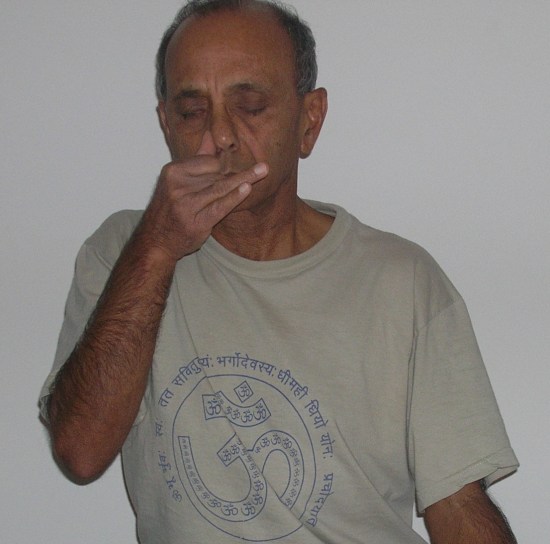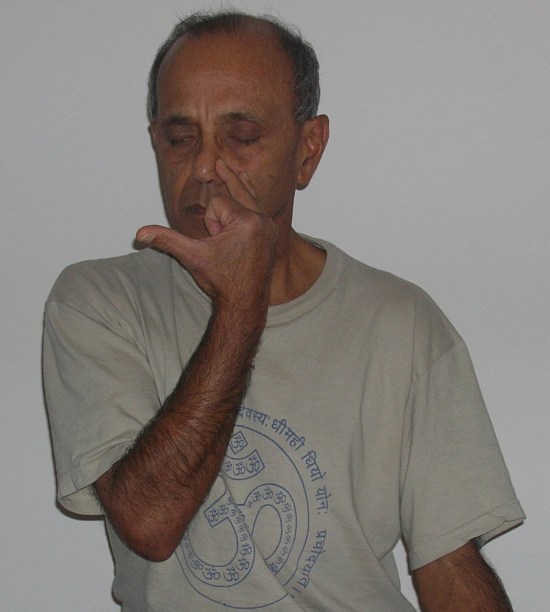In the past, I have written about the concept of kumbhaka (breath retention). I also described a few of the pranayama techniques that involve the practice of kumbhaka. In today’s post I will discuss kumbhaka as part of one of most commonly practiced pranayama techniques – alternate nostril breathing (Naadi Shuddhi or Anuloma Viloma). I have discussed the basic technique for Naadi Shuddhi in an earlier post.
In a previous post, I also introduced the concept of bandhas (pranic locks). These bandhas are usually applied while the breath is being retained in kumbhaka. It is, therefore, natural and common to practice both kumbhaka and bandha together.
In the Integral Yoga style that I practice and teach, the concept of kumbhaka and bandhas is introduced after the student has become comfortable with the basic rhythm of the Naddi Shuddhi technique. Which means that one should be able to establish and maintain a ratio of 1:2 between inhalation and exhalation and be able to practice several rounds (six to eight at least) without any strain or discomfort. In my experience as an instructor, this usually takes about 8-10 weeks of regular practice for most students. Once comfortable with the basic rhythm, the student can begin to practice both kumbhaka and bandhas. However, these should be introduced into the practice in stages which are described below.
Throughout the practice, use deep and soft Ujjayi breathing technique for each inhalation and exhalation.
Step-by-step
Stage 1
- Sit in any comfortable sitting posture with the spine erect, eyes closed and shoulders relaxed.
- Make the Vishnu Mudra (shown in the picture to the right) with the right hand – make a soft fist, lift the thumb and the last two fingers up, keeping the middle two fingers at the base of the thumb. During the practice using this mudra, the thumb is used to close the right nostril whereas the ring finger is used to close the left nostril.
- With the left hand, make the Chin Mudra – join the tips of the index finger and the thumb, keeping the rest of the fingers open and relaxed. Keep the hand on the left knee, palm facing up.
- Use the right thumb to close the right nostril. To get started, exhale through the left.
- Begin the first round by inhaling through the left nostril.
- At the end of inhalation, close the left nostril with the ring finger and open the right. Then exhale through the right nostril.
- Inhale now through the right. At the end of inhalation, close the right nostril with the thumb again and exhale through the left.
- This completes one cycle of breathing.
- Make sure to use deep and soft Ujjayi breaths for each inhalation and exhalation and establish a ratio of 1:2 between the durations of inhalation and exhalation. Continue for about 2-3 similar cycles.
Stage 2
- Follow steps 1 through 5 as given in stage 1.
- At the end of each inhalation, close both the nostrils – right nostril with the thumb and the left nostril with the ring finger and apply Jalandhara Bandha (chin lock). Apply kumbhaka for a duration that feels comfortable. The basic guideline for breath retention is that the quality and depth of the succeeding breath should not be compromised.
- Release the bandha and exhale through the other nostril and continue this sequence for each cycle of Naadi Shuddhi pranayama.
Stage 3
Follow the same steps as in stage 2. At the end of inhalation, apply both Jalandhara bandha (chin lock) as well as Mula Bandha (root lock).
Stage 4
In addition to the breath retention at the end of inhalation, you can attempt breath retention at the end of each exhalation as well. Usually it is much harder for most students to retain breath at the end of exhalation. So experiment with the practice and hold the breath only if and for as long as comfortable.
Stage 5
While maintaining a ratio of 1:2 between inhalation and exhalation, you may like to work on building up the duration of breath retention as well. Swami Sivananda, in his book on Pranayama, recommends the following rations for inhalation/internal kumbhaka/exhalation/external kumbhaka:1:1:2:0.5; 1:2:2:0.5; 1:3:2:0.5, 1:4:2:1.
Once again, we should always follow the basic guideline that breath retention should do done for a duration such that the subsequent breath remains deep, soft and gentle, without any strain or discomfort.


Sir,
I am from Chennai, I like to learn more on pranayama techniques, can you guide me.
Your teaching is very good sir, thank you.
Regards,
Sarathy
Please continue to read my blog where I have discussed most of the commonly practiced pranayama techniques. You can also visit my youtube channel (https://www.youtube.com/user/scmittal01) for more visual instructions.
Hello Sir,
I have been advised to practice Anulom Vilom 50 times MAXIMUM, each time.
I would like to practice Anulom Vilom twice a day or, if possible, three times a day. Would that be too much? I don’t want to go overboard, but I don’t want to do too little either.
There are different opinions as to how many times a day and for long each time. Also, some say it has to be done with an empty stomach, others do not even mention that.
In your opinion, do we need to practice more than once a day and for how long each time? What would be too little?
Thank you!
Hi Bertha,
I am not aware of any upper or lower limit for the practice of anuloma viloma. As per Hatha Yoga Pradipika, you can practice it up to four times a day. It is perhaps best to get the guidance from the teacher who has suggested the practice. Yes, I also believe that pranayama practice, and if fact all yoga practices, should be done on an empty stomach.